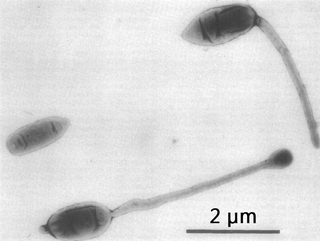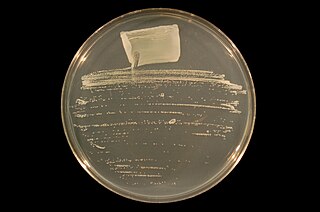
Pseudomonadota is a major phylum of Gram-negative bacteria. The renaming of several prokaryote phyla in 2021, including Pseudomonadota, remains controversial among microbiologists, many of whom continue to use the earlier name Proteobacteria, of long standing in the literature. The phylum Proteobacteria includes a wide variety of pathogenic genera, such as Escherichia, Salmonella, Vibrio, Yersinia, Legionella, and many others. Others are free-living (non-parasitic) and include many of the bacteria responsible for nitrogen fixation.

Acidobacteriota is a phylum of Gram-negative bacteria. Its members are physiologically diverse and ubiquitous, especially in soils, but are under-represented in culture.

Agrobacterium is a genus of Gram-negative bacteria established by H. J. Conn that uses horizontal gene transfer to cause tumors in plants. Agrobacterium tumefaciens is the most commonly studied species in this genus. Agrobacterium is well known for its ability to transfer DNA between itself and plants, and for this reason it has become an important tool for genetic engineering.

The Hyphomicrobiaceae are a family of bacteria. Among others, they include Rhodomicrobium, a genus of purple bacteria.

Bradyrhizobium is a genus of Gram-negative soil bacteria, many of which fix nitrogen. Nitrogen fixation is an important part of the nitrogen cycle. Plants cannot use atmospheric nitrogen (N2); they must use nitrogen compounds such as nitrates.

Ensifer is a genus of nitrogen-fixing bacteria (rhizobia), three of which have been sequenced.
Rhodopseudomonas is a genus of bacteria from the family Nitrobacteraceae.
Neorhizobium galegae is a Gram negative root nodule bacteria. It forms nitrogen-fixing root nodules on legumes in the genus Galega.
Pararhizobium giardinii is a Gram negative root nodule bacteria. It forms nitrogen-fixing root nodules on legumes, being first isolated from those of Phaseolus vulgaris.
Neorhizobium huautlense is a Gram negative root nodule bacterium. It forms nitrogen-fixing root nodules on Sesbania herbacea.
Allorhizobium vitis is a plant pathogen that infects grapevines. The species is best known for causing a tumor known as crown gall disease. One of the virulent strains, A. vitis S4, is responsible both for crown gall on grapevines and for inducing a hypersensitive response in other plant species. Grapevines that have been affected by crown gall disease produce fewer grapes than unaffected plants. Though not all strains of A. vitis are tumorigenic, most strains can damage plant hosts.
Pararhizobium capsulatum is a bacterium from the genus Pararhizobium which was isolated from eutrophic forest pond in Germany.
Neorhizobium is a genus of Gram-negative soil bacteria that fix nitrogen. It was recently segregated from the genus Rhizobium. Neorhizobium forms an endosymbiotic nitrogen-fixing association with roots of legumes.
Pararhizobium is a genus of Gram-negative soil bacteria that fix nitrogen. Some species of Pararhizobium form an endosymbiotic nitrogen-fixing association with roots of legumes.
Thermonema is a Gram-negative, chemoheterotrophic and aerobic genus from the phylum Bacteroidota.
Chitinophagaceae is an aerobic or facultatively anaerobic and rod-shaped family of bacteria in the phylum Bacteroidota.
The Rhodothermales are an order of bacteria.
Balneolales is an order of bacteria.
Hymenobacteraceae is a family of bacteria in the phylum Bacteroidota.
Thermoguttaceae is a family of bacteria.





